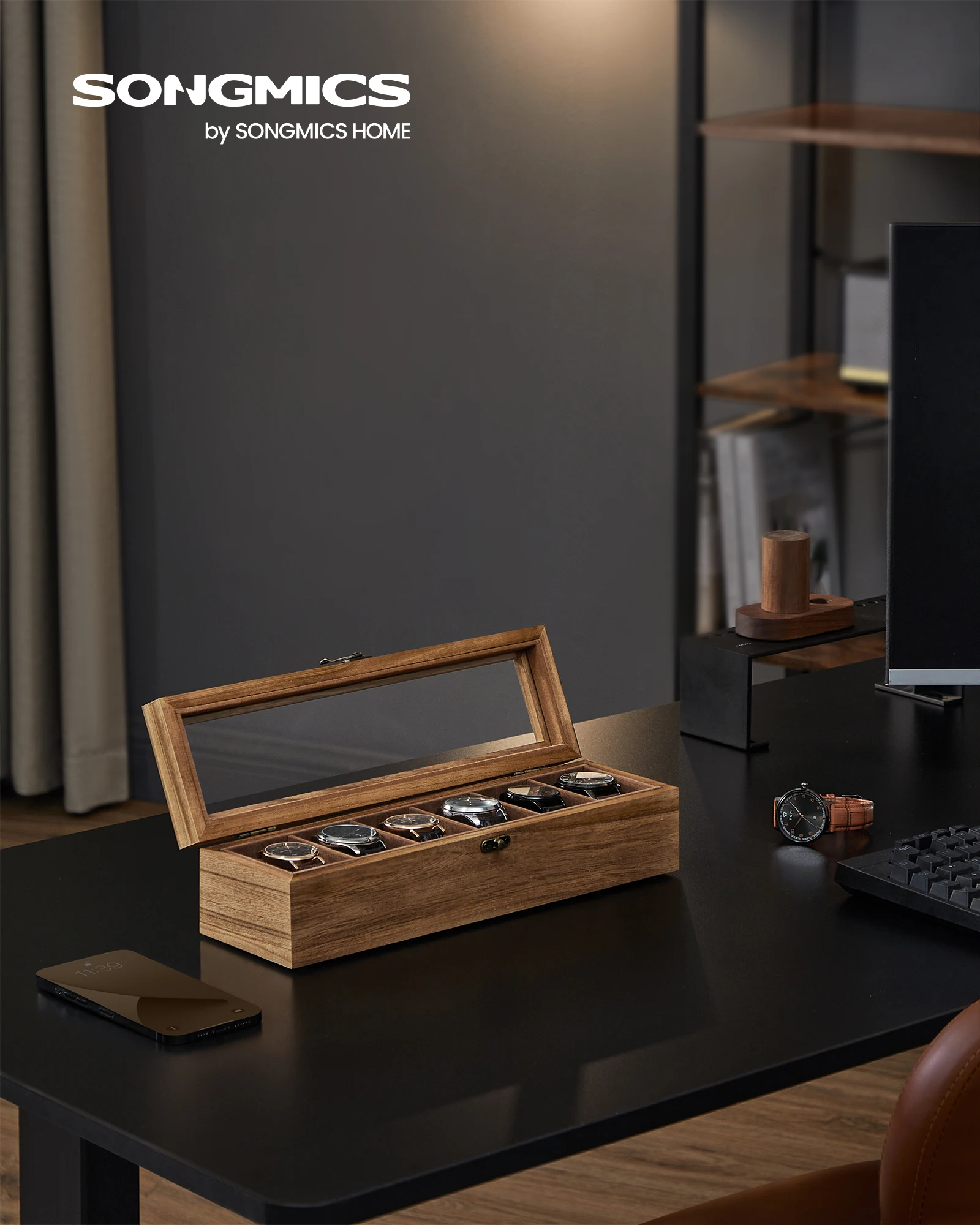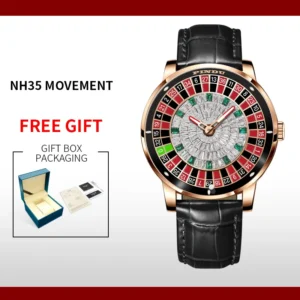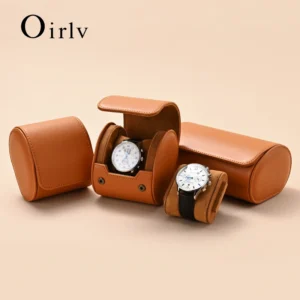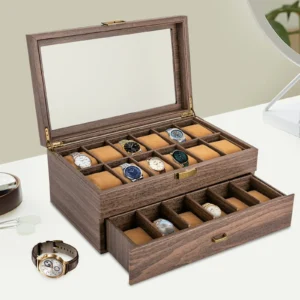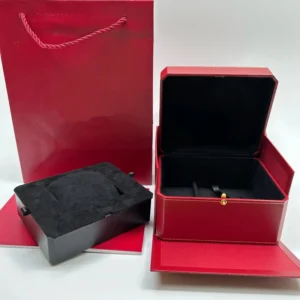Introduction: The Importance of Proper Watch Storage
For watch enthusiasts and collectors, proper storage is not just about organization—it’s about preserving both the function and value of your timepieces. Whether you own a single cherished watch or a growing collection, the way you store your watches directly impacts their longevity, appearance, and performance.
Men’s watch collections often present unique storage challenges due to their variety of materials, sizes, and mechanisms. From robust dive watches with metal bracelets to elegant dress pieces with delicate leather straps, each timepiece deserves careful consideration in how it’s stored.
Improper storage can lead to numerous issues:
– Scratched cases and crystals from watches touching each other
– Dust accumulation affecting dials and movements
– Mechanical issues from improper positioning or lack of movement
– Leather strap deterioration from humidity or improper airflow
Finding the perfect balance between protection and accessibility is key. The ideal storage solution should both safeguard your watches and allow you to appreciate and access your collection with ease.
Understanding men’s watch storage essentials is the foundation of proper timepiece care. Throughout this guide, we’ll explore various storage options—from watch boxes and winders to travel cases and display stands—helping you find the perfect solution for your essential storage items for men’s watches.
Understanding Watch Vulnerabilities: What Damages Your Timepieces
Dust and Debris
Even microscopic particles can cause damage to your timepieces. When dust accumulates on watch dials or finds its way into the case, it can create micro-scratches on surfaces and potentially interfere with movement functions. Regular cleaning and proper storage are your first line of defense against this common threat.
Moisture and Humidity
Watches thrive in environments with controlled humidity levels, ideally between 40-60%. Excessive humidity can cause condensation inside the case, potentially leading to dial discoloration, rusting of metal components, and degradation of lubricants essential for proper movement function. Too little humidity, on the other hand, can cause leather straps to dry and crack.
Extreme Temperatures
Temperature fluctuations are particularly damaging to watches. Exposure to temperatures below 32°F/0°C or above 100°F/38°C can affect lubricants within the movement, expand or contract materials at different rates, and even damage batteries in quartz watches. Consistent moderate temperatures are ideal for watch longevity.
Direct Sunlight and UV Rays
Prolonged exposure to sunlight causes watch dials to fade over time, particularly those with colored faces. UV rays also accelerate the aging process of leather straps and can break down the lubricants inside the watch mechanism, leading to increased wear and potential failure.
Magnetic Fields
Modern life surrounds us with magnetic fields that can seriously impact mechanical watch accuracy. Common household items like speakers, refrigerators, tablets, and even some cabinet latches emit magnetic fields strong enough to affect watch movements, causing them to run too fast or too slow.
The essential men’s watch box features address these vulnerabilities by providing protected environments specifically designed for timepiece storage.
Essential Pre-Storage Preparation
Before storing your watches, proper preparation ensures they remain in optimal condition:
Clean thoroughly: Using a soft microfiber cloth, gently wipe the watch case, crystal, and bracelet to remove oils, dirt, and fingerprints. For tougher grime, lightly dampen the cloth with water only—avoid chemical cleaners that can damage finishes. Pay special attention to areas between links and around the case back.
Use appropriate tools: Soft brushes (like unused toothbrushes) can help clean hard-to-reach areas between bracelet links. Always use watch-specific tools rather than household items that might scratch surfaces.
Prepare mechanical watches: For manual-wind watches, wind them fully before storage. For automatic watches being stored short-term, simply ensure they’re wound. For longer storage (over a week), allow them to stop naturally—constant tension on the mainspring for months isn’t ideal.
Set quartz watches properly: To preserve battery life when storing quartz watches long-term, pull the crown out to stop the movement. This simple step can significantly extend battery life.
Inspect for issues: Before storage is the perfect time to check for any problems requiring professional attention—loose hands, condensation under the crystal, or irregular timekeeping should be addressed before storing.
Understanding how to clean leather watch cases is particularly important, as leather requires specific care to prevent cracking or discoloration during storage periods.
Fundamental Storage Principles Every Man Should Follow
Regardless of which storage solution you choose, these core principles apply to all watch collections:
Use individual compartments: Each watch deserves its own dedicated space to prevent metal-on-metal contact that causes scratches and damage. Never allow watches to touch each other during storage.
Choose soft interior linings: Quality storage options feature protective microfiber, velvet, or dense foam linings that cradle watches safely. These materials prevent scratches while providing cushioning against impacts.
Position properly: Store watches face-up when possible, as this position puts the least stress on the stem and crown. If space constraints require side positioning, ensure the crystal faces away from hard surfaces.
Accommodate different sizes: Men’s watches range from slim dress pieces to bulky divers and chronographs. Your storage solution should have compartments large enough for oversized watches and adjustable features to secure smaller ones.
Separate materials: Keep leather straps away from metal bracelets, as the metals can transfer oils or color to leather. Watches with rubber straps should also be stored separately as some compounds can degrade neighboring materials over time.
Ensure proper airflow: Especially critical for leather straps, adequate air circulation prevents mold growth and material degradation. Completely sealed environments can trap moisture and damage organic materials.
These principles apply whether you’re using basic or high-end watch boxes and form the foundation for proper timepiece care.
Premium Watch Boxes: The Collector’s Foundation
For most collectors, a quality watch box serves as the cornerstone of proper storage. These purpose-built cases provide protection, organization, and often an elegant way to display prized timepieces.
The best watch boxes feature:
Versatile capacity options: From single-watch cases for your most treasured piece to boxes holding 12 or more watches for growing collections, size should match both current needs and future collection growth.
Premium materials: Fine hardwoods like walnut, cherry, and mahogany not only look sophisticated but also provide stable environments for watches. High-grade leather exteriors offer classic appeal, while modern carbon fiber options provide lightweight strength.
Protective features: Glass or acrylic viewing lids protect from dust while allowing visibility, secure closures prevent accidental opening, and quality hinges ensure long-term durability.
Cushion quality: Superior watch boxes include removable cushions with memory properties that conform to different bracelet sizes without stretching leather straps or applying excessive pressure.
Interior finishing: Soft, non-abrasive linings in materials like microsuede, velvet, or silk protect watch cases from scratches and provide gentle support.
Quality watch boxes typically range from $100-$500 for well-crafted options, with custom or luxury versions extending well beyond this range. When selecting one, consider both functional protection and how it complements your home decor, as it will likely be displayed on a dresser, desk, or shelf.
Our collection of luxury watch boxes offers premium storage solutions crafted from the finest materials to both protect and showcase your timepieces.
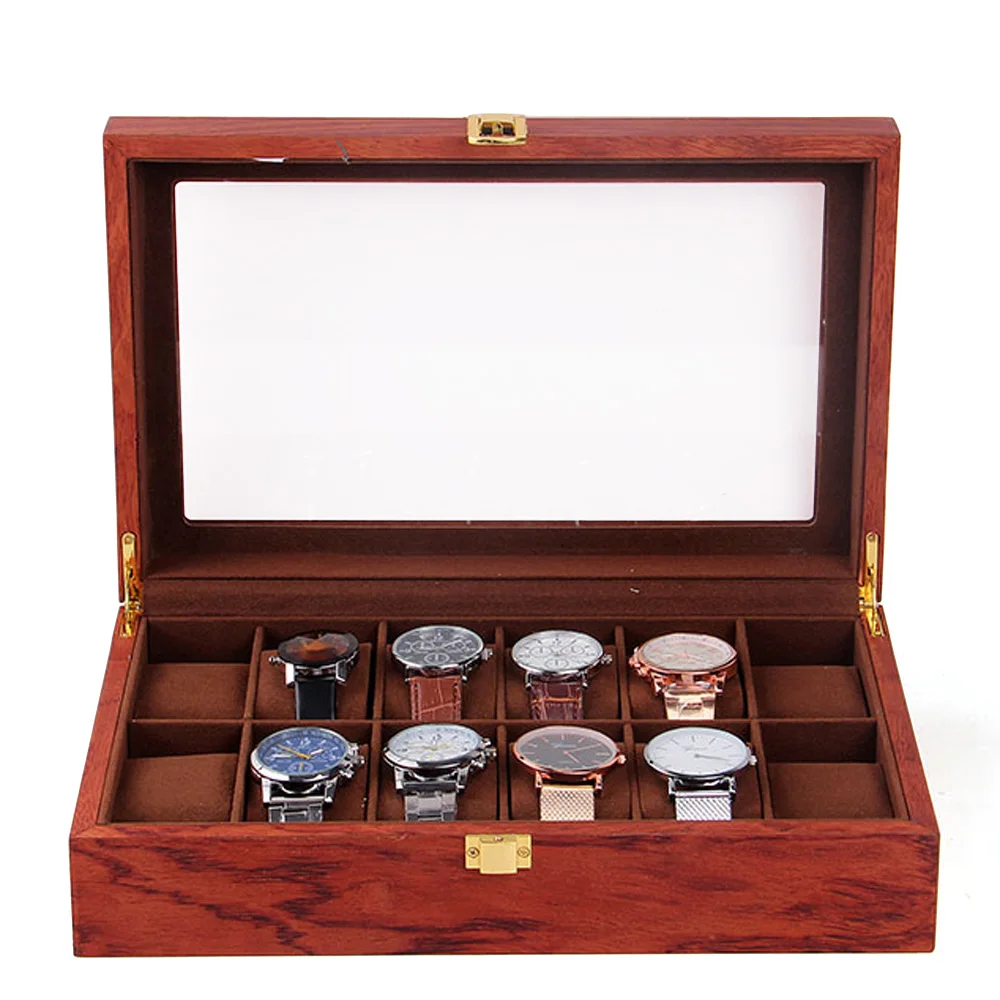
Watch Winders: Keeping Automatics Ready and Preserved
For collectors with automatic watches, watch winders serve a specialized yet essential purpose. These devices mimic the natural wrist movement that keeps automatic watches running, eliminating the need to reset watches between wearings while maintaining proper lubrication of movement components.
Key Technical Specifications
When selecting a watch winder, understanding these technical factors ensures proper care for your timepieces:
TPD (Turns Per Day): Different watch movements require specific rotation frequencies. Most automatic watches require between 650-1,800 TPD, though some specialized movements may need different settings. Adjustable TPD settings allow customization for different watches in your collection.
Rotation Direction: Some watch movements wind only clockwise, others counterclockwise, and many bi-directionally. Quality winders offer programmable direction settings to accommodate various movement types.
Motor Quality: The best winders use quiet, Japanese-made motors with ball bearings rather than bushings, providing years of reliable, silent operation.
Single-watch winders start around $100 for quality options, while multi-watch systems can range from $200 to several thousand dollars depending on capacity and features.
Understanding watch winder TPD settings is crucial for properly maintaining automatic watches during storage. For those with automatic timepieces, our selection of watch winders provides options for collections of all sizes.
Travel Storage Solutions: Protection On The Move
When traveling with watches, protection becomes even more critical as timepieces face additional risks from movement, handling, and environmental changes.
Travel storage options balance protection with portability:
Single Watch Pouches: Ideal for daily carry or bringing one alternative watch on a trip, these slim pouches feature protective padding while adding minimal bulk to your luggage.
Watch Rolls: Perfect for carrying 2-5 watches, these cylindrical cases secure each timepiece in individual compartments, preventing movement and contact during transport. Quality watch rolls feature leather, canvas, or ballistic nylon exteriors with soft interior dividers.
Hard Travel Cases: For maximum protection, especially when checking luggage, hard cases with foam interiors offer impact resistance and complete security. Many feature customizable foam inserts to create perfect-fitting recesses for specific watches.
When selecting travel storage, prioritize materials that combine durability with protection. Full-grain leather offers excellent protection and develops a handsome patina over time, while synthetic materials may provide better water resistance for adventure travel.
Knowing how to protect your watch when traveling helps ensure your timepieces arrive safely at your destination. Our collection of watch travel cases offers options for every journey, from business trips to adventure travel.
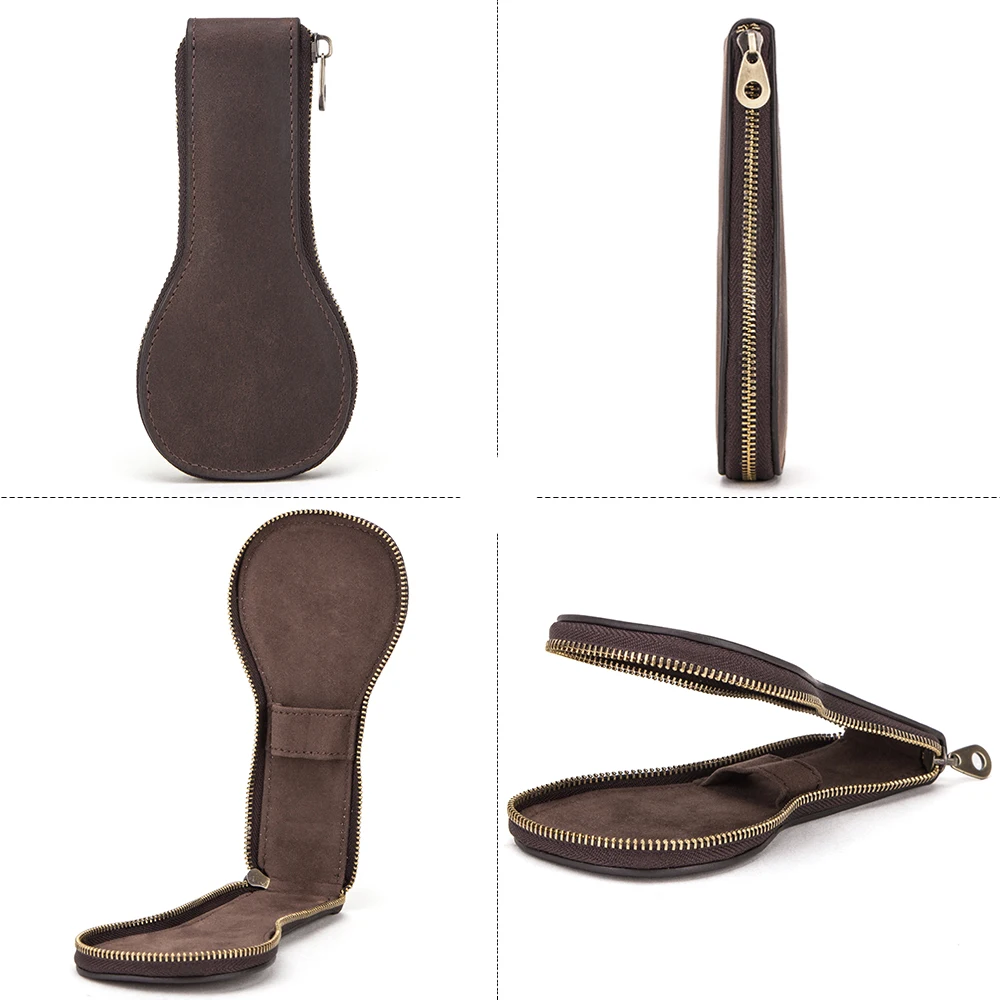
Display Stands and Valets: Daily Wear Convenience
For the watches in your regular rotation, display stands and valets offer the perfect balance of protection and accessibility. These solutions are ideal for the 1-3 watches you wear most frequently, keeping them visible and ready while preventing damage from haphazard placement.
Quality watch stands feature:
- Stable bases that prevent tipping even when supporting heavier watches
- Soft contact points to protect case backs from scratches
- Proper support for watches with both closed and open bracelets/straps
Materials range from classic hardwoods that develop character over time to modern metals and acrylics that complement contemporary decor. The best stands incorporate protective elements like microsuede or felt on all contact surfaces.
Watch valets expand on this concept by including additional storage for everyday items like keys, coins, cufflinks, and other accessories—creating an organized landing spot for your daily essentials.
Placing these stands on nightstands, dressers, or desks not only protects watches but also creates a meaningful ritual for beginning and ending your day. Our selection of watch display holders provides options that both protect and showcase your favorite timepieces. For those interested in creating a more comprehensive presentation, our decorative watch display guide for collectors offers additional inspiration.
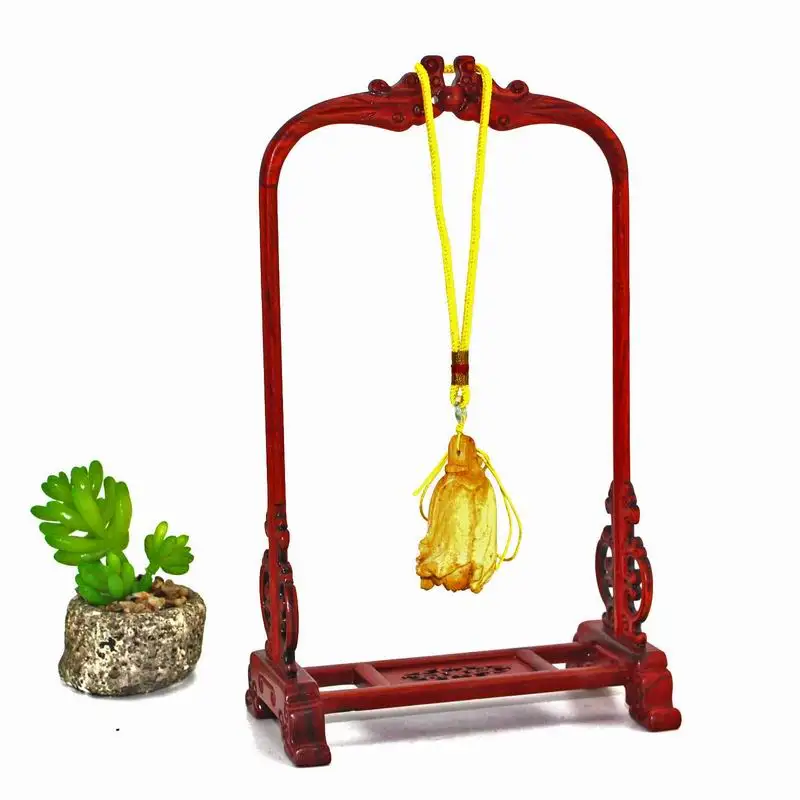
Drawer Organizers and Trays: Discreet Collection Management
For collectors who prefer keeping their timepieces secure and out of sight, drawer organizers and trays offer an excellent alternative to display-focused solutions. These systems integrate with existing furniture, maximizing space efficiency while maintaining proper watch protection.
Key considerations for drawer storage include:
- Drawer depth: Ideal drawers should be at least 3-4 inches deep to accommodate watch cushions and clearance for larger watches
- Soft lining materials to prevent scratches from drawer movement
- Adjustable dividers to create custom compartments for different watch sizes
- Stackable designs that maximize vertical space for growing collections
Unlike display cases, drawer storage presents unique challenges for humidity control. Consider adding silica gel packets or small humidity control devices to maintain optimal conditions, especially for drawers in bathrooms or external walls subject to temperature fluctuations.
Understanding how deep a watch drawer should be ensures your timepieces have adequate clearance and protection. Our watch drawer organizer options provide discreet, efficient storage solutions that protect your collection while keeping it organized and accessible.
Secure Storage for Valuable Timepieces
For high-value timepieces, standard storage solutions may not provide adequate security. When your collection includes significant investments, additional protective measures become necessary.
Watch safes represent the ultimate protection, offering:
- Theft deterrence through steel construction and locking mechanisms
- Fire protection ratings that shield watches from damage during emergencies
- Environmental controls maintaining optimal temperature and humidity
- Integrated watch winders for automatic watches requiring movement
When selecting a watch safe, consider these security features:
* Lock type (key, combination, biometric)
* Steel thickness and construction quality
* Mounting/anchoring options to prevent removal
* Interior customization for watch storage
Beyond physical security, collectors with valuable pieces should consider:
* Professional appraisals documenting each watch’s value
* Specialized insurance covering theft, loss, and damage
* Photographic documentation of serial numbers and distinguishing features
For those with extensive men’s watch collections, balancing security with accessibility creates an optimal storage strategy that protects your investment while still allowing enjoyment of your timepieces.
Special Considerations for Different Watch Types
Different watch styles and mechanisms have unique storage requirements that deserve special attention:
Automatic Watches
These self-winding timepieces require regular movement to maintain accuracy and proper lubrication. If unworn for extended periods (over two weeks), consider using watch winders set to the correct rotation frequency for optimal maintenance. When not using winders, periodic manual winding (every 2-3 weeks) helps maintain movement health.
Quartz Watches
Battery-powered watches benefit from having the crown pulled out during extended storage, which stops the movement and extends battery life. Additionally, keep quartz watches away from speakers, magnetic closures, and electronic devices that generate magnetic fields, as these can affect the stepping motor’s function.
Dive Watches
Even with exceptional water resistance, dive watches benefit from occasional gasket maintenance. Before long-term storage, ensure the crown is fully screwed down. Rubber and silicon straps should be cleaned with mild soap and water before storage to remove salt residues and skin oils that can degrade the material over time.
Dress Watches
Often featuring thinner cases and delicate leather straps, dress watches require gentle handling during storage. Use slightly smaller cushions for watches with leather straps to prevent stretching, and ensure adequate airflow around the strap to prevent moisture accumulation.
Vintage Watches
Pieces produced before the 1990s typically have different service needs and storage considerations. They generally lack the water resistance of modern watches, making humidity control even more critical. Store vintage pieces in slightly drier environments (30-40% humidity) and handle with particular care, as replacement parts may be difficult or impossible to source.
Watch Accessories, Watch Holder
$94.51 Select options This product has multiple variants. The options may be chosen on the product pageLuxury Watch Boxes, Men's Watch Boxes, Single Watch Box
Price range: $903.35 through $980.97 Select options This product has multiple variants. The options may be chosen on the product pageSingle Watch Travel Case, Watch and Jewelry Box, Watch Roll Travel Case
Price range: $93.44 through $140.65 Select options This product has multiple variants. The options may be chosen on the product pageMen's Watch Organizer, Watch Display Case, Watch Organizer
Price range: $112.68 through $169.45 Select options This product has multiple variants. The options may be chosen on the product pageAutomatic Watch Winder, Luxury Watch Winder, Single Watch Box
$307.39 Select options This product has multiple variants. The options may be chosen on the product pageLuxury Watch Boxes, Luxury Watch Travel Case
Price range: $200.33 through $224.57 Select options This product has multiple variants. The options may be chosen on the product page
Maintaining Your Watch Storage Systems
Your storage solutions themselves require regular maintenance to continue providing optimal protection for your timepieces:
Wooden watch boxes benefit from occasional dusting and treatment with appropriate wood conditioners every 6-12 months, avoiding silicone-based products that can transfer to watches.
Leather exteriors should be conditioned twice yearly with leather-specific products to prevent drying and cracking.
Humidity control elements like silica gel packets should be replaced or recharged every 3-6 months, depending on your local climate.
Watch winder motors should be tested periodically for proper function, rotation speed, and unusual noise that might indicate wear.
Cushions and pillows eventually compress and lose their supportive properties. Replace them when they no longer hold watches securely or have become misshapen.
Signs that your storage system needs upgrading include:
* Overcrowded conditions where watches touch each other
* Difficulty closing lids or drawers completely
* Worn or compressed cushions that no longer support properly
* Damaged hinges, locks, or other hardware
Proper maintenance of watch organizers for everyday use ensures they continue to provide the protection and organization your collection deserves.
Beyond Storage: Complete Watch Collection Management
Comprehensive watch care extends beyond physical storage to include systematic management of your collection:
Implement rotation schedules for watches not on winders to ensure each piece gets regular wear. This prevents lubricants from settling and keeps gaskets from drying out.
Create a servicing calendar tracking when each watch was last serviced and when the next maintenance is due. Most mechanical watches benefit from servicing every 5-7 years.
Maintain documentation for each timepiece, including:
- Warranty cards and purchase receipts
- Service records and timing results
- Authentication certificates
Original boxes and papers (stored separately from watches)
Consider digital tracking through specialized collection management apps or simple spreadsheets recording:
- Purchase date and price
- Reference numbers and serial numbers
- Service history
- Current market value
Understanding the horology art and passion behind watch collecting enhances appreciation for proper storage and maintenance practices, elevating the collecting experience beyond mere ownership.
Frequently Asked Questions About Men’s Watch Storage
How often should automatic watches be worn if stored long-term?
Ideally, automatic watches should be worn at least once every two weeks to keep lubricants properly distributed. If this isn’t possible, using a quality watch winder or manually winding the watch periodically (every 2-3 weeks) helps maintain movement health.
Can watches with leather straps be stored in watch winders?
While possible, it’s not ideal. The constant position can cause leather straps to develop permanent bends or creases. If using a winder for a watch with a leather strap, periodically adjust the strap position or consider temporarily swapping to a bracelet during extended winder storage.
Is it safe to store watches in a bank safe deposit box?
Safe deposit boxes provide excellent security but may lack humidity and temperature control. If using one for long-term storage, place watches in airtight containers with humidity control packets and check them periodically. This option works better for rarely worn investment pieces than for a regular rotation.
Should watch boxes be kept in a closet or displayed openly?
This depends on your priorities. Open display allows easy access and visual enjoyment but exposes boxes to more light and dust. Closet storage offers better protection from sunlight and environmental fluctuations but reduces accessibility. Many collectors find that storing watches in the bedroom offers a good balance, keeping pieces accessible but away from kitchen humidity or living room sun exposure.
How can you tell if a watch has been affected by magnetism?
The most common sign is sudden, significant time-keeping deviation—typically running several minutes fast per day. Modern smartphones have apps that can detect magnetic fields, allowing a basic check. When in doubt, a watchmaker can both test for magnetism and demagnetize the watch if necessary.

